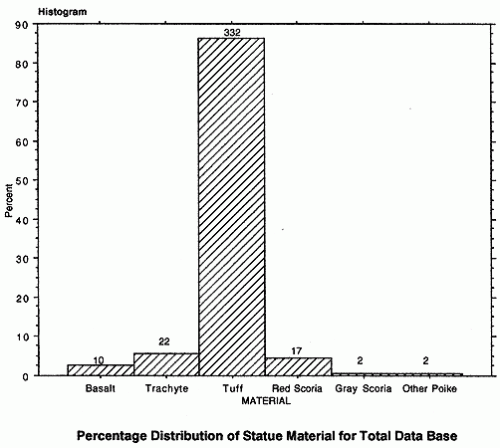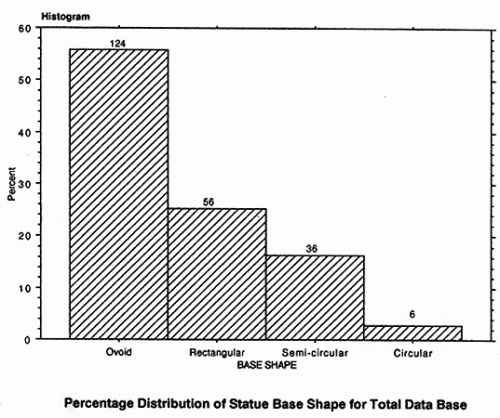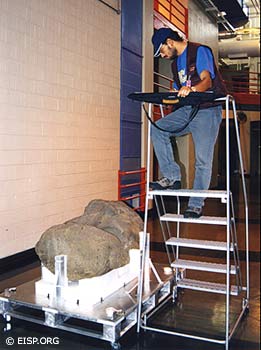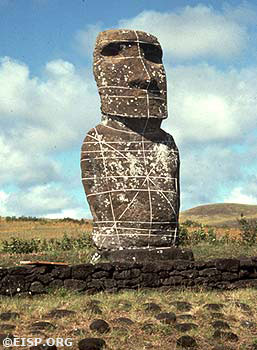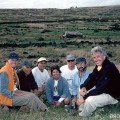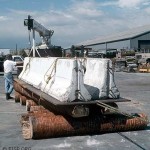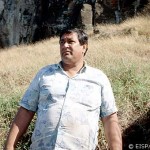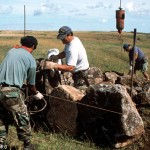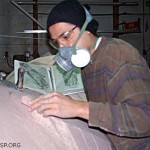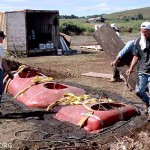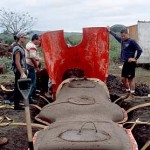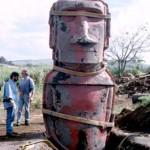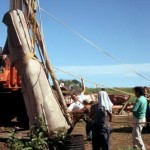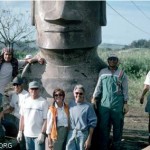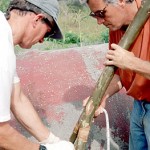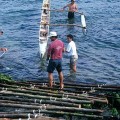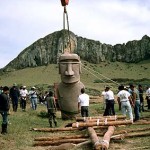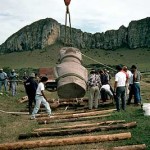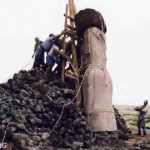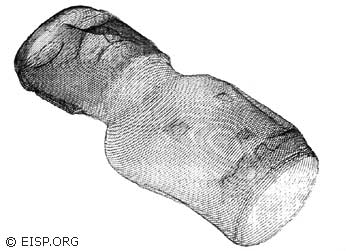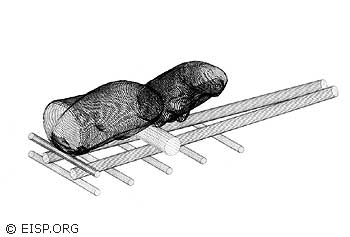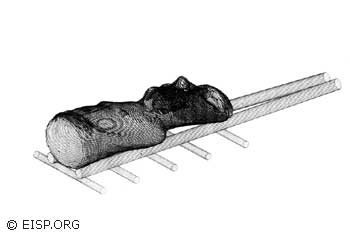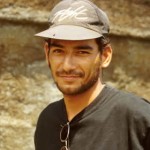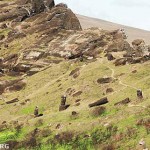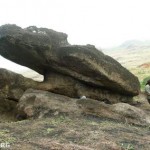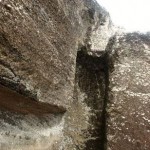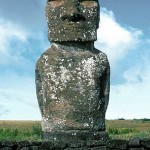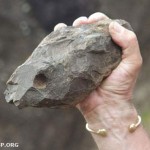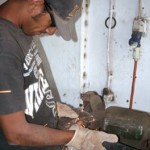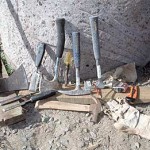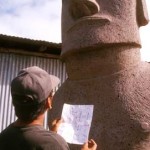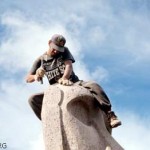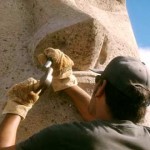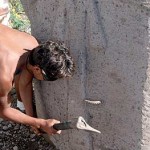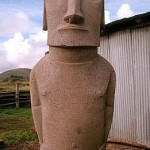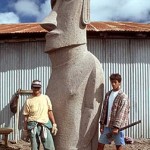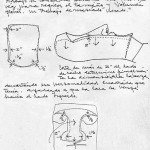EISP History: 1990s
Statue Material & Base Shape Distribution Histograms
Statue Distribution Map
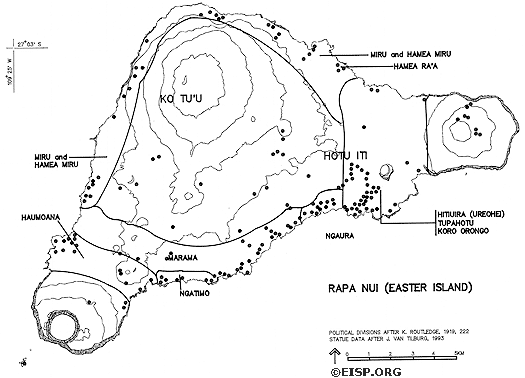 Distribution of monolithic statue sites relative to Routledge’s (1919) kin group divisions. Computer drafting by Gordon Hull. From Easter Island Archaeology, Ecology and Culture by Jo Anne Van Tilburg. London: British Museum Press and Smithsonian Institution Press, 1994.
Distribution of monolithic statue sites relative to Routledge’s (1919) kin group divisions. Computer drafting by Gordon Hull. From Easter Island Archaeology, Ecology and Culture by Jo Anne Van Tilburg. London: British Museum Press and Smithsonian Institution Press, 1994.
Documenting Objects in Museums and Collections
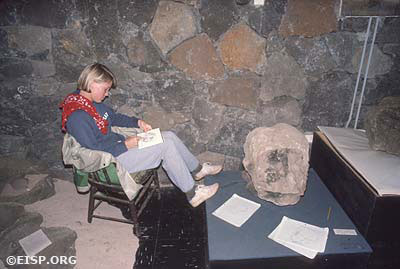
Lynn Lockie documenting a moai head at the Englert Museum, Hanga Roa, Rapa Nui. ©1984 EISP/JVT/ Photo: D. C. Ochsner.
Following the work of Lynn Lockie in 1984, EISP expanded to include museum collections research. Statues, fragments, pukao and portable stone sculpture have been documented using the same attribute list that was applied to moai in archaeological contexts. Ten intact moai, as well as 55 other stone sculptural objects including moai heads, torsos, pukao and fragments from major museums in the US, the UK, Chile, New Zealand, France, Belgium and Canada are now included in the EISP database. These objects have been culled from more than double that number that we have examined, and represent objects with the best documented provenance and what we consider to be the greatest formal relevance to moai design and chronology.
Beginning in 1992, Cristián Arévalo Pakarati produced finished drawings of the most important of these objects in the island museum and on the Chilean mainland. Some of those drawings were included in Van Tilburg’s first paper for the British Museum, “HMS Topaze on Easter Island: Hoa Hakananai’a and Five Other Museum Statues in Archaeological Context” (British Museum Press, 1992). From 2000 to the present, Van Tilburg and Arévalo Pakarati have conducted further research at the British Museum; the National Library of Scotland and the Scottish National Museum in Edinburgh; the Ulster Museum in Belfast; the Pitt Rivers Museum in Oxford and, in the US, at the Peabody Museum, Cambridge; the Smithsonian Institution; the American Museum of Natural History, NYC; the Metropolitan Museum of Art, Chicago’s Field Museum of Natural History and elsewhere.
[Read More…]
Easter Island Statue Project History: 1990s
Goals and Methods
Major goals from 1990 to 2000 were to further expand our field work beyond the published survey area and to include Ahu Tepeu and a wide variety of interior sites; to add to our database those statues found in museum collections, and to gather comparative data from other Polynesian monolithic statue sites in Mo’orea, the Marquesas Islands and Tonga. New object type categories were created to accommodate expanded iconographic fields, including the more intensive recording of rock art directly related to statues or statue sites. Van Tilburg and Cristián Arévalo Pakarati worked independently or together throughout much of this time. Field seasons were short, usually 3 to 4 weeks every year, although two field seasons were accomplished back-to-back in each of two years.
In the Field
We worked intensively at Ahu Tepeu, where our goal was to integrate the excavation data from previous work with the on-site statue data and with descriptions of sculptural objects in museum collections. At Vai Mata, we documented the associated hare paengaand other features more fully and, as well, accomplished a preliminary survey of Quadrant 26. We mapped several interior sites and moai fragments at La Pérouse, using new hand-held GPS and video equipment as important tools.
Megaliths and Mariners: Experimental Archaeology on Easter Island
This is an edited version specifically for publication on this web site of a paper originally published in “Onward and Upward! Papers in Honor of Clement W. Meighan” (K. Johnson, ed. 2005) © Jo Anne Van Tilburg and Ted Ralston
Our Research Model
Our model for Rapa Nui statue carving is Polynesian canoe building. Experimental anthropology has established maritime methods for pre-contact Hawai’i and elsewhere in Oceania. Canoe builders and handlers were, like statue carvers, specialists who performed expert (and often sacred) work at the behest of powerful chiefs and for their communities. Canoe experts were socially and politically powerful.
In addition to the adze, the tool kit employed in canoe building contained the clamp, chisel, cordage and drill. Apprentices began by developing basic skills, including roughhewing and hauling massive logs. When wood materials were inadequate to build the desired size vessel, planks or logs were spliced and patched. Practiced methods of joinery provided strength, flexibility and protection of lashings from the sea, and finish details were carved with intricate artistry.
Positioning, stepping, raising and rigging a canoe mast required precision timing and a well-coordinated work force. A canoe’s survival in rough seas depended upon robust and durable cord lashing, which was required to withstand forces of many thousands of pounds per square inch. Complex methods of lashing outrigger components to both single and double hull canoes required such specialty tools as the keke (or ke’ke), a Y-shaped lash-tightening device that varied in size. A device such as the keke may be depicted in the Y-shaped bas-relief tattoos on the chins of some moai.
Transport Experiment: Measurement Diagrams & Models
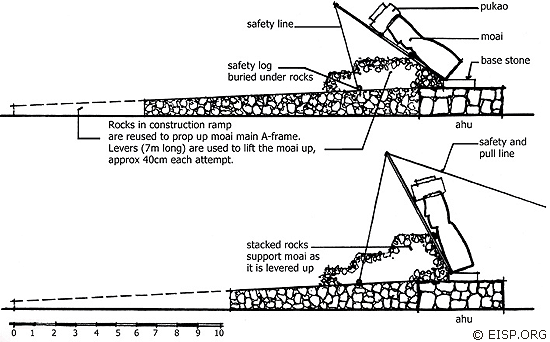
Drawings by Jan Van Tilburg depict our method of raising the statue. Supervised by Raphael Rapu, this part of the work was jointly directed by Van Tilburg and C. Cristino. ©1998 EISP/JVT.
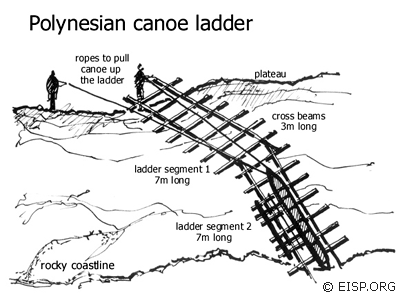
Drawings by Jan Van Tilburg showing the Polynesian canoe ladder, the basic design concept of our statue transport A-frame sledge.
Wire diagrams arrived at after photogrammetric work accomplished at Ahu Akivi depict the statistically average statue used in computer simulations and then in our transport experiment. ©1992 EISP/JVT.
The Rapanui carver’s perspective: Notes and observations on the experimental replication of monolithic sculpture (moai)
This is an abbreviated version of a paper originally published in Pacific Art: Persistence, Change and Meaning (Herle et al. eds. Adelaide: Crawford House, 2002 for citations and notes).
Real Time and Individual Energy
Experimental archaeology is the systematic approach used to test, evaluate and explicate method, technique, assumption, hypothesis and theory at all levels of archaeological research. This paper employs a replicated moai to describe relationships between real time and individual energy, and explores the subjective artistic dimension of moai carving during an experiment lasting 32 8-hour days. It is drawn from journal notes taken by Van Tilburg from October 1997 to May 1998, by Arévalo from December 1988 to July 1999, and on written correspondence in English and Spanish between the authors.
Carvers and Craving
On Easter Island (Rapa Nui) ethnographic data related to monolithic stone carving methods, production techniques and carvers are scant. In the 1800s some Rapanui persons were distinguished by their relationships to ancestors who had been famed stone carvers. Katherine Routledge, co-leader of the Mana Expedition to Easter Island, 1913-1915, collected some names of statues that were said, in actuality, to be names of carvers, and believed them to have veracity.
[Read More…]
Rano Raraku Exterior Quarry: Moai sketches and neck tracings (RR-002-077)
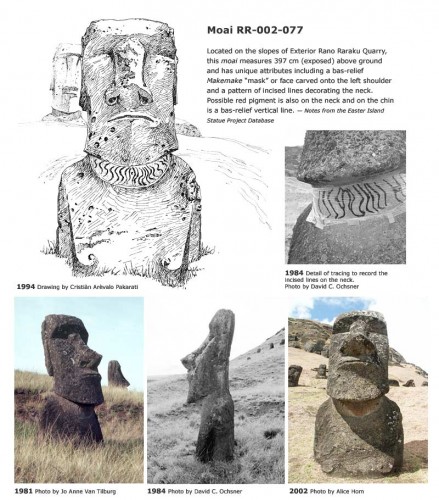
Moai RR-002-077 Located on the slopes of Exterior Rano Raraku Quarry, this moai measures 397 cm (exposed) above ground and has unique attributes including a bas-relief makemake ‘mask’ or face carved onto the left shoulder and a pattern of incised lines decorating the neck. Possible red pigment is also on the neck and on the chin is a bas-relief vertical line. — Notes from the Easter Island Statue Project Database
 English
English  Español
Español 